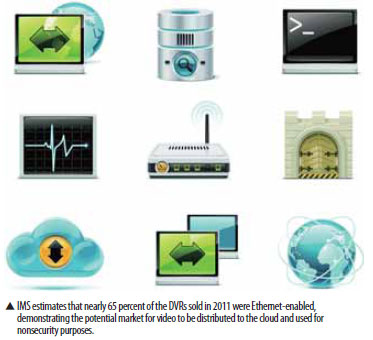4.ANALYTICS TO THE EDGE
IMS predicts that in the coming years, the types of applications that can be performed at the edge on the device's main processor will increase. This will mainly be driven by the availability of more powerful processors and partly by the refinement of VCA applications to make them less processor-intensive.
Basic analytics will become standard features, and more advanced, “paid for” analytics will be performed at the edge. Over time, an increasing variety of analytics will be added as standard features, at no extra cost to the customer. Moreover, more powerful processors will enable multiple VCA algorithms to be performed at the same time to improve detection capabilities.
VCA is increasingly being used outside of the security realm, such as driver assistance cameras and interactive gaming consoles (such as Microsoft's Kinect). Some of these new markets for VCA offer high-volume potential, which is attracting the attention of chip makers.
5.MORE M&A ACTIVITY
Despite the economic turmoil, M&A activity in the security industry has continued over the last couple of years. However, video surveillance acquisitions have not been at the forefront of these deals; generally, M&A activity has been on a much smaller scale. Most recently, March Networks announced its plans to be acquired by Infinova in a deal worth around $90 million.
IMS' annual report on the global video surveillance equipment market estimated that the market in 2010 was worth more than $9 billion in 2010, with nearly 40 percent of all sales contributed by the top 15. We forecast that network video surveillance equipment sales will exceed 25 percent in 2012, despite uncertainty in the Eurozone. While we will not see a spate of billion-dollar deals in 2012, it is likely that a greater volume of midsized deals will complete in the next 12 months.
6.LOOKING UP TO THE CLOUD
At the end of 2010, IMS forecast the increased traction of cloud-based video surveillance, also known as VSaaS. The market certainly picked up in 2011, with notable sales growth of around 20 to 30 percent. However, the market is still emerging, developing and evolving. IMS believes that there are a number of potential avenues for suppliers of VSaaS to explore in the coming year.
A majority of the security cameras used in small and midsized enterprises are solely used for security reasons. However, some of the more tech-savvy users are beginning to leverage and monetize video from their existing systems. Rather than simply leaving video dormant on a hard-disk drive (HDD), business owners could post or stream video to the Internet, allowing customers to see real-time footage of the place they intend to visit. Video could be integrated with Groupon, TripAdvisor, Yelp or even Google Street View. Prior investment in security equipment could be transformed from an expense to a revenue-generating tool. IMS estimates that nearly 65 percent of the DVRs sold in 2011 were Ethernet-enabled, demonstrating the potential market for video to be distributed to the cloud and used for nonsecurity purposes.
7.TURNING POINT FOR SPINNING DISKS
The average price of HDDs has been falling for more than two decades. Now faced with the consequences of the recent flooding in Thailand, the video surveillance storage industry could well see the effects of a change to this trend.
The reported extent of the disruption to HDD production differs from vendor to vendor. Official statements of predicted price increases vary from 0 to 180 percent. The net result for 2012 is likely to be a softening to the trend of falling storage prices.
 8.VMS, NOT AS WE KNOW IT
8.VMS, NOT AS WE KNOW IT
IMS predicts that 2012 will see a raft of innovation in the VMS space, as vendors attempt to stave off the threat of commoditization.
For the more established VMS vendors to continue to enjoy the historic high growth rates, they need to accomplish two key things: (1) maintain and increase presence in the upper market tier and (2) grow in the middle and lower tiers of the market.
The key selling feature of many VMS systems has been “openness,” and while the ability to integrate to a broad range of video surveillance brands is still desirable, this has become more of a basic expectation. IMS believes that VMS vendors will work on the following innovations in the next 12 months.
A.USER INTERFACE
While different VMS solutions do contain unique features, user interfaces in general are fairly similar. Manufacturers will seek to develop simpler and more intuitive user interfaces in the coming year.
B.MOBILE APPLICATIONS
Applications for mobile platforms, such as iOS and Android, will be the front of many VMS manufacturers' arsenal in the coming year. The market for mobile video surveillance applications is still relatively immature; this is true for both the technology and the market demand. Simple concepts, such as leveraging location services, would provide enhanced user experience.
C.SITUATIONAL AWARENESS
The integration between access control and video surveillance systems has been a well-trodden path in the last few years, and this trend will persist through 2012. VMS vendors will look to further develop their offerings from pure-play VMS platforms to security management platforms. VMS vendors have already sought to bridge the gap between supply and demand for situational awareness by implementing “PSIM-like” features in their platforms (such as enhanced functionality with Google or Esri maps). IMS believes that 2012 will see an acceleration of this trend.